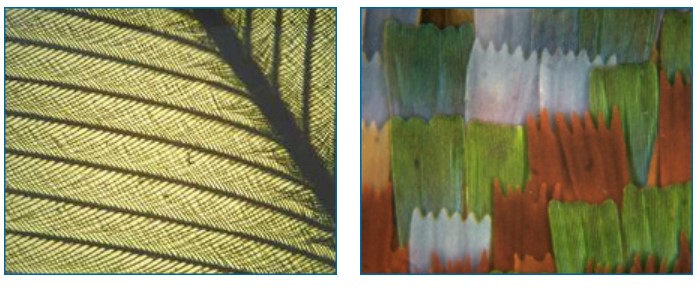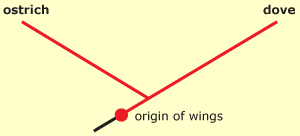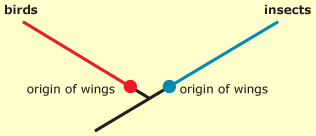Though the eyes we’ve seen so far differ in many ways, they all share the ability to sense light. They all have light-sensing cells (called photoreceptor cells) that relay information to the brain or nerve mass — and some of the eyes are laid out in similar ways. But why are they similar? In terms of evolution, there are two basic explanations for similar structures:
Homologies are similar characteristics shared by two different organisms because they were inherited from a common ancestor. For example, the wing of a dove and the wing of an ostrich are homologous, even though the dove is an efficient flyer and the ostrich is flightless; they were both inherited from a common ancestor with wings.
Analogies are similar characteristics shared by two different organisms because of convergent evolution. For example, the wing of a dove and the wing of a butterfly are analogous; the bird lineage and the insect lineage evolved wings independently of one another.
Homologous structures reflect the common ancestry of living things. Because doves and ostriches share a common ancestor, their wings are deeply similar on a structural level. At the same time, the differences between dove wings and ostrich wings (in color, size, shape, etc.) reflect the diversity of life and the unique evolutionary path that each of these two lineages has taken since the time of that common ancestor.
To figure out if two anatomical structures are homologous, scientists evaluate many different lines of evidence. Here are some key criteria used to judge whether a trait is homologous:
- Similar position: are these structures in the same place on the bodies of the organisms?
Dove wings and ostrich wings are located in similar places on their bodies, just below the neck and attached to the shoulder girdle. Butterfly wings, on the other hand, attach to the second and third segments of the animal’s thorax, just behind its first pair of legs.
Ostriches and doves are certainly proportioned differently, but their wings are located in similar places on their bodies, below the neck and attached to the shoulder girdle. Butterfly wings are placed and attached quite differently. Ostrich photo provided by H. Vannoy Davis © California Academy of Sciences; dove photo provided by Joyce Gross; butterfly photo provided by T. W. Davies © California Academy of Sciences. - Similar composition: are these structures made up of the same types of cells and tissues?
Dove wings and ostrich wings are made up of similar bone and muscle cells and are covered in feathers with a similar structure. Butterfly wings, on the other hand, have a very different construction: they are built from a scaffolding of veins, spanned by a thin membrane with a dense covering of delicate scales.
While birds do sport a variety of feathers, all feathers share the same basic composition (on the left, a close-up of a feather). A closer look at a butterfly wing (right) reveals a very different composition. feather photo provided by the Bozeman Kiwanis; butterfly wing scales photo provided by Stennett S. Heaton © California Academy of Sciences. - Similar development: did these structures arise from the same embryonic parts? Do they have a similar pattern of development?
Dove wings and ostrich wings look quite similar to one another as they develop in their eggs. Butterfly wings, on the other hand, develop from discs of specialized tissue as the wingless caterpillar metamorphoses into the winged adult.
Dove and ostrich wings are homologous and match on all three criteria. Butterfly and bird wings, on the other hand, are analogous and do not meet any of the criteria. Analogous structures may look similar on the surface, but since their similarity is due to convergence rather than common ancestry, analogous structures generally don’t meet all of the criteria above.


